|
|
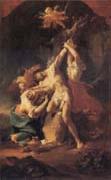 |
Paul Troger
|
|
Austrian Painter, 1698-1762
was an Austrian painter, draughtsman and printmaker of the late Baroque period. Troger's illusionistic ceiling paintings in fresco are notable for their dramatic vitality of movement and their palette of light colors. Paul Troger??s style, particularly in his frescoes, dominated Austrian painting until the end of the 18th century and profoundly influenced significant artists of the next generation, notably Franz Anton Maulbertsch, Josef Ignaz Mildorfer, Johann Wenzel Bergl. Paul Troger was born on October 30, 1698, in Welsberg, in the Puster Valley of Tyrol (now Bolzano-Bozen, Italy). At the age of 16, under the patronage of the aristocratic Tyrolean von Firmian family, he visited Fiume and became a pupil of Giuseppe Alberti.[2] He painted his first fresco ??Three Angels with the Cross and Putti??, in the Chiesa del Calvario, Kaltern am See/Caldaro al Lago, Bolzano, Italy (1722). In 1722, the prince-bishop of Gurk sent Paul Troger to Venice, where he discovered the works of Giovanni Battista Piazzetta, and Giovanni Battista Pittoni. Troger also studied in Rome with Sebastiano Ricci, in Naples with Francesco Solimena and in Bologna, the leading artistic centers of Italy at the time. On his return to Austria, Troger first worked in Salzburg from 1726 to 1728, where he painted the "Glory of Saint Cajetan" on the ceiling of St. Cajetan??s Church, Salzburg (1728). He afterwards established himself in Vienna, where the art of ceiling frescoes was, however, dominated by Johann Michael Rottmayr and Daniel Gran. Paul Troger became the favourite fresco painter in Lower Austrian monasteries in collaboration with the architect Josef Munggenast. In 1753, he joined the Imperial Academy of Fine Arts. |
|
 |
Per Krafft the Elder
|
|
(16 January 1724, Arboga - 7 November 1793, Stockholm) was a Swedish portraitist. He was the father of the artists Per Krafft the Younger and Wilhelmina Krafft.
|
|
|
|
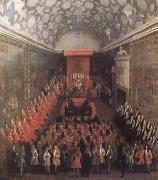 |
Peter Tillemans
|
|
Flemish Painter, ca.1684-1734
was a Flemish painter, best known for his works on sporting and topographical subjects. Alongside John Wootton and James Seymour, he was one of the founders of the English school of sporting painting. From 1708 until his death he lived and worked in England. Tillemans was born in Antwerp in c. 1684, the son of a diamond-cutter, and studied painting there under various masters. As he was the brother-in-law of another Flemish painter, Pieter Casteels, it is assumed that he married before leaving Antwerp. Like other artists from the Low Countries such as Dirk Maas, Jan Wyck and William van de Velde, Tillemans moved to England. In Tillemans's case he moved in 1708, induced to do so by a picture-dealer called Turner: he spent the rest of his life working there. In his Sportsmen in a Landscape (1971), Aubrey Noakes offers this description of Tillemans: If we may judge from his success Tillemans was a socially agreeable and charming man. A portrait of him reveals that he was a gentle, friendly-looking fellow, with long curling hair, presumably his own and not a wig, such as was commonly worn by members of the upper and professional classes in the late eighteenth century. A chronic sufferer of asthma, Tillemans retired to Richmond "on account of his ill state of health". He died at the house of Dr Cox Macro (1683?C1767, later chaplain to George II) in Little Haugh Hall, in Suffolk, on 5 December 1734 (the previous day he "had been busy on a horse portrait") and was buried on 7 December at Stowlangtoft. His collection of paintings had been sold in an auction conducted by Dr Macro on 19 and 20 April 1733 and included paintings by James Tillemans, probably a son or other relation, |
|
 |
Phoebe Traquair
|
|
The leading artist the Arts and Crafts movement in Edinburgh at the turn of the century ,
(1852-1936) |
|
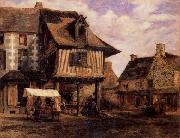 |
Pierre etienne theodore rousseau
|
|
Paris 1812-Barbizon 1867
French painter of the Barbizon school, was born in Paris, of a bourgeois family which included one or two artists.At first he received a business training, but soon displayed aptitude for painting. Although his father regretted the decision at first, he became reconciled to his son leaving business, and throughout the artist's career (for he survived his son) was a sympathizer with him in all his conflicts with the Paris Salon authorities. Theodore Rousseau shared the difficulties of the romantic painters of 1830 in securing for their pictures a place in the annual Paris exhibition. The whole influence of the classically trained artists was against them, and not until 1848 was Rousseau adequately presented to the public. He had exhibited one or two unimportant works in the Salon of 1831 and 1834, but in 1836 his great work "La descente des vaches" was rejected by the vote of the classic painters; and from then until after the revolution of 1848 he was persistently refused. He was not without champions in the press, and under the title of "le grand refus" he became known through the writings of Thor, the critic who afterwards resided in England and wrote under the name of Burger. During these years of artistic exile Rousseau produced some of his finest pictures: "The Chestnut Avenue", "The Marsh in the Landes" (now in the Louvre), "Hoar-Frost" (now in America); and in 1851, after the reorganization of the Salon in 1848, he exhibited his masterpiece, "The Edge of the Forest" (also in the Louvre), a picture similar in treatment to, but slightly varied in subject from, the composition called "A Glade in the Forest of Fontainebleau", in the Wallace Collection at Hertford House, London. Up to this period Rousseau had lived only occasionally at Barbizon, but in 1848 he took up his residence in the forest village, and spent most of his remaining days in the vicinity. He was now at the height of his artistic power, and was able to obtain fair sums for his pictures (but only about one-tenth of their value thirty years after his death), and his circle of admirers increased. He was still ignored by the authorities, for while Narcisse Virgilio Diaz was made Chevalier of the Legion of Honour in 1851, Rousseau was left undecorated at this time, but was nominated shortly afterwards. At the Exposition Universelle of 1853, where all Rousseau's rejected pictures of the previous twenty years were gathered together, his works were acknowledged to form one of the finest of the many splendid groups there exhibited. But during his lifetime Rousseau never really conquered French taste, and after an unsuccessful sale of his works by auction in 1861, |
|
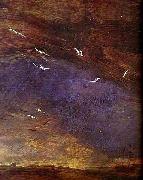 |
Pieter Bruegel the Elder
|
|
(Dutch pronunciation:c. 1525 - 9 September 1569) was a Flemish Renaissance painter and printmaker known for his landscapes and peasant scenes (Genre Painting). He is sometimes referred to as "Peasant Bruegel" to distinguish him from other members of the Brueghel dynasty, but is also the one generally meant when the context does not make clear which "Bruegel" is being referred to. From 1559 he dropped the 'h' from his name and started signing his paintings as Bruegel.
There are records that he was born in Breda, Netherlands, but it is uncertain whether the Dutch town of Breda or the Belgian town of Bree, called Breda in Latin, is meant. He was an apprentice of Pieter Coecke van Aelst, whose daughter Mayken he later married. He spent some time in France and Italy, and then went to Antwerp, where in 1551 he was accepted as a master in the painter's guild. He traveled to Italy soon after, and then returned to Antwerp before settling in Brussels permanently 10 years later. He received the nickname 'Peasant Bruegel' or 'Bruegel the Peasant' for his alleged practice of dressing up like a peasant in order to mingle at weddings and other celebrations, thereby gaining inspiration and authentic details for his genre paintings. He died in Brussels on 9 September 1569 and was buried in the Kapellekerk. He was the father of Pieter Brueghel the Younger and Jan Brueghel the Elder. Both became painters, but as they were very young children when their father died, it is believed neither received any training from him. |
|
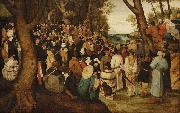 |
Pieter Brueghel the Younger
|
|
(1564 or 1565 - 10 October 1636) was a Flemish painter, known for numerous copies after his father Pieter Brueghel the Elder's paintings and nicknamed "Hell Brueghel" for his fantastic treatments of fire and grotesque imagery.
Pieter Brueghel the Younger was the oldest son of the famous sixteenth-century Netherlandish painter Pieter Brueghel the Elder (known as "Peasant Brueghel") and Mayken Coecke van Aelst. His father died in 1569, when Pieter the younger was only five years old. Then, following the death of his mother in 1578, Pieter, along with his brother Jan Brueghel the Elder ("Velvet Brueghel") and sister Marie, went to live with their grandmother Mayken Verhulst (widow of Pieter Coecke van Aelst). She was an artist in her own right, and according to Carel van Mander, possibly the first teacher of the two sons. The family moved to Antwerp sometime after 1578 and Pieter possibly entered the studio of the landscape painter Gillis van Coninxloo (1544 - 1607). In the 1584/1585 registers of Guild of Saint Luke, "Peeter Brugel" is listed as an independent master. On 5 November 1588 he married Elisabeth Goddelet, and the couple had seven children.
He painted landscapes, religious subjects and fantasy paintings. For this last category he often made use of fire and grotesque figures, leading to his nickname "Hell Brueghel".
Apart from these paintings of his own invention, Pieter Brueghel the Younger also copied the works his father had created by using a technique called pouncing. His genre paintings of peasants lack Pieter the Elder's subtlety and humanism, and emphasize the picturesque
|
|
|
|
 |
Quincy Tahoma
|
|
1921-1956,Native American Navajo painter. He was a Navajo shepherd, who in 1932 went to the Santa Fe Indian School where he learnt to paint in Dorothy Dunn's 'Studio' class and became one of the most significant pupils |
|
|
|
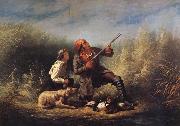 |
Ranney William Tylee
|
|
German-born American Painter, 1813-1857
American painter. He spent six formative years in the hill country of North Carolina. By 1834 he was working and studying drawing in New York, but two years later he went to Texas to join in the war for independence. Although he returned to New York a year later, it was not until 1846, with the outbreak of the Mexican War, that Ranney began to use his Western experience as the basis for his painting. With the encouragement of the American Art Union, he executed three types of Western subject: the Western trapper or hunter, pursuing a dangerous life on the prairies, as in Trapper's Last Shot (1850; untraced; engraved and lithographed by T. Dwight Booth); the pioneer family, heading across the plains with children, dogs and goods, as in Advice on the Prairie (1853; Malvern, PA, Claude J. Ranney priv. col.); and the dangers of emigration, for example Prairie Fire. |
|
|
|
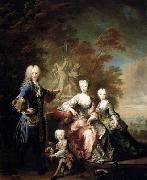 |
Robert Levrac Tournieres
|
|
Thomas William Robertson (9 January 1829 ?C 3 February 1871), usually known professionally as T. W. Robertson, was an Anglo-Irish dramatist and innovative stage director best known for a series of realistic or naturalistic plays produced in London in the 1860s that broke new ground and inspired playwrights such as W.S. Gilbert and George Bernard Shaw. |
|
|
|
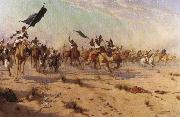 |
Robert Talbot Kelly
|
|
(1861 - 1934) was an English orientalist landscape and genre painter, author and illustrator.
Kelly was born in Birkenhead, Cheshire, the son of Irish landscape artist Robert George Kelly. He left school in 1876 to take up work in a firm of cotton traders, but was also taught art by his father, exhibiting under the name R. G. Kelly Jnr.
In the early 1880s, inspired by the places he saw while on vacation on an ocean cruise ship, Talbot-Kelly decided to take up his father's profession. He left his employment in 1882, travelled by boat to North Africa, and settled in Egypt in 1883, acquiring a studio in Cairo and becoming fluent in Arabic. He travelled throughout the country, writing about and painting the people and scenes he encountered both in towns and in the desert. He spent a considerable time with the Bedouin tribes who he described and illustrated in his 1902 book, "Egypt painted and described" (A & C Black). As his name became known he also earned an income from private commissions. He stayed in Egypt until 1915 when for reasons of health and age he returned to London - though he continued to paint constantly.
An Arab cafe in Cairo (from "Egypt painted and described", 1902)"Egypt painted and described", his first illustrated travel book, was published in 1902 (by A & C Black), and was an account of his impressions and experiences of that country during his long stay there; an exhibition of his Egyptian views was also held at the Fine Art Society in the same year. His paintings and writing showed a great empathy and respect for local people and culture, especially that of the desert Bedouin Arabs. |
|
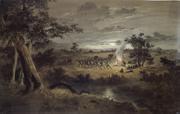 |
S.T.Gill
|
|
Australian original water-colour drawings and prints
b.1818-d.1880
also known by his signature S.T.G., was and English-born Australian artist. Gill was born in Perriton, Somerset, England, the eldest of five children. His father, the Reverend Samuel Gill, became headmaster of a school at Plymouth, and the son was educated first at this school and then at Dr Seabrook's Academy, Plymouth. Having moved to London, he was employed as a draughtsman and watercolour painter by the Hubard Profile Gallery, before departing for the colony of South Australia in 1839 with his parents. |
|
|
|
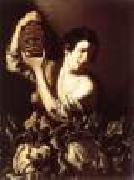 |
SALINI, Tommaso
|
|
Italian painter, Roman school (b. 1575, Roma, d. 1625, Roma).Italian painter. He has long been famed as a witness in the lawsuit of 1603 brought by his friend and biographer, Giovanni Baglione, against Caravaggio. His activity as a painter of religious works, still-lifes and genre paintings has been reconstructed in the decades following 1950, although his chronology remains uncertain. He entered the Accademia di S Luca in 1605 but was afterwards expelled on account of his 'difetto', to be readmitted in 1618. He was decorated with the Order of the Golden Spur and became a member of the Congregazione di Virtuosi al Pantheon. |
|
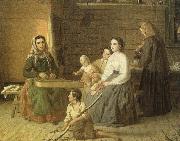 |
samuel taylor coleridge
|
|
Born: 21 October 1772
Birthplace: Devonshire, England
Died: 25 July 1834 (heart attack)
Best Known As: The author of The Rime of the Ancient Mariner |
|
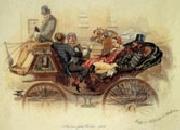 |
Samuel Thomas Gill
|
|
(Devon, England 1818 - Melbourne 1880 ) Australian/British Artist
Australian/British Artist,also known by his signature S.T.G., was and English-born Australian artist. Gill was born in Perriton, Somerset, England, son of the Reverend Samuel Gill, a Baptist minister, and his first wife, Winifred Oke. Rev. Gill became the headmaster of a school at Plymouth, where the son was first educated, then he continued to Dr Seabrook's Academy, Plymouth. Having moved to London, Gill was employed as a draughtsman and watercolour painter by the Hubard Profile Gallery, before departing for the colony of South Australia in 1839 with his parents, arriving in December. Gill arrived in Adelaide, aged 21 and established a studio in 1840, and called for those 'desirous of obtaining a correct likeness' of themselves and their families, friends, animals and residences to contact him. His activities soon expanded to include street scenes and public events, including the newly discovered copper mines at Burra Burra as well as the departure of Charles Sturt's expedition for the interior on 8 October 1844. |
|
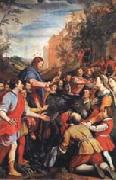 |
Santi Di Tito
|
|
Italian Painter and Architect, 1536-ca.1602
was an Italian painter of Late-Mannerist or proto-Baroque style, what is sometimes referred to as Contra-Maniera. Born in Borgo San Sepolcro, in Tuscany. There is little documentation to support the alleged training under Bronzino or Baccio Bandinelli. From 1558-1564, he worked in Rome on frescoes in Palazzo Salviati and the Sala Grande of the Belvedere (Homage of the People) alongside Giovanni de' Vecchi and Niccol?? Circignani. He acquired a classical trait, described as Raphaelesque by S.J. Freedburg. This style contrasted with the reigning ornate Roman painterliness of the Federico and Taddeo Zuccari or their Florentine equivalents: Vasari, Alessandro Allori, and Bronzino. Among his pupils was Cigoli. Another pupil named Francesco Mochi became a sculptor in the Baroque style, creating among other pieces, the colossal Saint Veronica', supervised by Gianlorenzo Bernini and placed in the crossing of St. Peter's Basilica in Rome. After returning to Florence in 1564, He joined the Accademia del Disegno, and he did not venture to paint outside of Tuscany. He contributed two unusual paintings for the Duke's study and laboratory, the Studiolo of Francesco I in the Palazzo Vecchio. This artistic project was partly overseen by Giorgio Vasari. These paintings are (the Sisters of Fetonte and Hercules and Iole). |
|
|
|
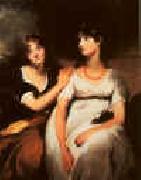 |
Sir Thomas Lawrence
|
|
1769-1830
British
Sir Thomas Lawrence Galleries
was a notable English painter, mostly of portraits.
He was born in Bristol. His father was an innkeeper, first at Bristol and afterwards at Devizes, and at the age of six Lawrence was already being shown off to the guests of the Bear as an infant prodigy who could sketch their likenesses and declaim speeches from Milton. In 1779 the elder Lawrence had to leave Devizes, having failed in business and Thomas's precocious talent began to be the main source of the family's income; he had gained a reputation along the Bath road. His debut as a crayon portrait painter was made at Oxford, where he was well patronized, and in 1782 the family settled in Bath, where the young artist soon found himself fully employed in taking crayon likenesses of fashionable people at a guinea or a guinea and a half a head. In 1784 he gained the prize and silver-gilt palette of the Society of Arts for a crayon drawing after Raphael's "Transfiguration," and presently beginning to paint in oil.
|
|
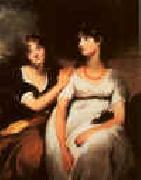 |
Sir Thomas Lawrence
|
|
1769-1830
British
Sir Thomas Lawrence Galleries
was a notable English painter, mostly of portraits.
He was born in Bristol. His father was an innkeeper, first at Bristol and afterwards at Devizes, and at the age of six Lawrence was already being shown off to the guests of the Bear as an infant prodigy who could sketch their likenesses and declaim speeches from Milton. In 1779 the elder Lawrence had to leave Devizes, having failed in business and Thomas's precocious talent began to be the main source of the family's income; he had gained a reputation along the Bath road. His debut as a crayon portrait painter was made at Oxford, where he was well patronized, and in 1782 the family settled in Bath, where the young artist soon found himself fully employed in taking crayon likenesses of fashionable people at a guinea or a guinea and a half a head. In 1784 he gained the prize and silver-gilt palette of the Society of Arts for a crayon drawing after Raphael's "Transfiguration," and presently beginning to paint in oil.
|
|
|
|
|
|
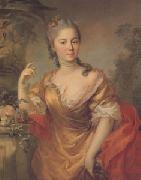 |
Stefano Torelli
|
|
Bologna 1712-St Petersburg 1784
was an Italian painter. He was born in Bologna. He studied first under his father, Felice Torelli, and then under Francesco Solimena. The future King of Poland, Augustus III, brought him to Dresden in 1740, where he painted altar-pieces and ceiling decorations, many destroyed in the Seven Years' War. He painted figures in Canaletto's twenty-nine views of Dresden (1741). In 1762 he was summoned to the Russian court where he painted ceilings in the Royal Palace, and some portraits, among the latter one of the Empress Elizabeth in armor. He was a clever caricaturist, and etched a few plates. He died in St. Petersburg. |
|
|
|
 |
Tack Augustus Vincent
|
|
A painter of portraits, murals and abstractions.
American, 1870-1949
American, 1870-1949, was an American painter of portraits, landscapes and abstractions. He was born in Pittsburgh, Pennsylvania in 1870 and moved with his family to New York in 1883. After graduating from St. Francis Xavier College in New York City in 1890, Tack studied at the Art Students League of New York until 1895. He is believed to have frequented the studio of painter and stained glass designer John La Farge, whose portrait he painted around 1900. He had his first solo exhibition at the Kraushaar Galleries in New York City in 1896. The following year he moved to an artists?? colony in Deerfield, Massachusetts, where he met and later married Agnes Gordon Fuller, daughter of artist George Fuller. Tack maintained a studio in New York from 1894 until the end of his life. He had frequent exhibitions at New York City galleries. From 1900 until the 1920s his work was shown regularly at the Worcester Art Museum, at the Carnegie International exhibitions in Pittsburgh, and at the Pennsylvania Academy of the Fine Arts in Philadelphia. He taught at the Art Students League of New York between 1906 and 1910 and at Yale University from 1910 to 1913. About 1914 to 1915 his work attracted the notice of Duncan Phillips, who became his close friend and chief patron. Phillips and Tack also collaborated on the organization of the Allied War Salon of 1918. Tack died in 1949 in New York City. |
|
|
|
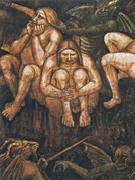 |
Taddeo di Bartolo
|
|
Italian Gothic Era Painter, ca.1362-1422
Italian painter. Taddeo, son of the barber Bartolo di Mino, was under 25 in 1386 when he was first recorded, painting statuettes of angels for the new choir-stalls in Siena Cathedral. In 1388-9 he was a counsellor to the Cathedral Works and in 1389 he was first listed as an independent painter. His earliest dated work is the polyptych of the Virgin and Child with Saints (1389; sold London, Christie's, 8 Dec 1950), painted for the chapel of S Paolo at Collegarli, near San Miniato al Tedesco. |
|
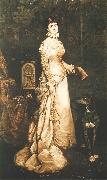 |
Tadeusz Ajdukiewicz
|
|
1852 in Wieliczka ?C January 9, 1916 in Krak??w) was a Polish painter.
From 1868 to 1873, he followed Władysław Luszczkiewicz classes in the Fine art school of Krakow. Later, he was in Vienna and Munich and in J??zef Brandt's atelier. In 1877, he travelled to Paris and Near East. In 1882, he lived in Vienna, where he worked for the aristocracy. In 1883, he went to London, where he made Prince of Wales' portrait. In 1884, to Constantinople, he was sultan Abdhulhamid II's guest. And he woked later in Sofia, Saint Petersburg and Bucharest. He joined the Polish Legions in 1914, during World War I, and he died in one of the battles of this war. He's first cousin was Zygmunt Ajdukiewicz. |
|
|
|
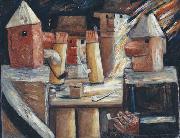 |
Tadeusz Makowski
|
|
(21 January 1882 - 1 November 1932) was a prominent Polish painter active in France for most of his life. He was born in Oświęcim. Makowski attended the Academy of Fine Arts in Krakew. He studied under Jan Stanisławski and Jezef Mehoffer. In 1909, he departed for Paris. Makowski started off as a landscape painter but then shifted towards Post-Impressionism and Cubism. However, he is arguably most famous for his rural landscape paintings. He met Pablo Picasso,who was his good friend.
|
|
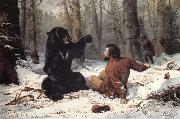 |
Tait Arthur Fitzwilliam
|
|
English-born American Painter, 1819-1905
American painter and lithographer of English birth. He spent the first three decades of his life in England and arrived in New York in 1850. Steeped in admiration for the subjects of Edwin Landseer and the style of the Pre-Raphaelites, he established himself as a realistic painter of animals and sporting scenes. For his images of Western hunters and trappers, he used as sources the works of George Catlin and William Ranney, artists who, unlike himself, had travelled extensively. He established a summer studio at a camp in the Adirondack Mountains, where he painted sporting scenes. These wilderness scenes, often composed around an anecdote, appealed to a wide popular audience, and from 1852 Currier & Ives as well as Louis Prang published a number of lithographs and chromolithographs of his work. Tait also composed still-lifes of game birds and, in his later career, barnyard scenes of sheep and chickens. His painting A Tight Fix: Bear Hunting in Early Winter |
|
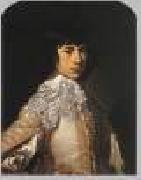 |
TASSEL, Jean
|
|
French Baroque Era Painter, ca.1608-1667
Son of Richard Tassel, with whose works his own were for a long time confused. He trained with his father and by 1634 was recorded in Rome, where he came into contact with his fellow Frenchmen Claude Lorrain, Nicolas Poussin and Sebastien Bourdon. Like the last he was influenced by the Bamboccianti, and he painted a number of low-life genre scenes at this period; these include Singers in a Tavern (Kassel, Schloss Wilhelmshehe) and Travellers Attacked (Warsaw, N. Mus.). He had returned to Langres by 1647, the date of his marriage, and continued to paint genre pictures after this, such as The Sawyers (Strasbourg, Mus. B.-A.) and The Marauders (Langres, Mus. St Didier). Other influences from Rome include Caravaggio, strong in a picture such as the Fortune-teller (sold Paris, Drouot, 1 April 1987, ) but far less apparent in the Presentation of the Infant Jesus (Dijon, Mus. B.-A.) and Tobias and the Angel (Dijon, Mus. B.-A.). However, the most lasting influence was that of the Romano-Bolognese school, seen in later pictures such as the Annunciation |
|
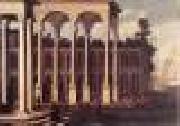 |
TASSI, Agostino
|
|
Italian painter, Roman school (b. 1578, Roma, d. 1644, Roma).
|
|
|
|
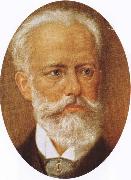 |
tchaikovsky
|
|
Born: 7 May 1840
Birthplace: Votkinsk, Russia
Died: 6 November 1893
Best Known As: Russian composer of The Nutcracker |
|
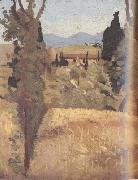 |
Telemaco signorini
|
|
Italian Painter, 1835-1901
was an Italian artist who belonged to the group known as the Macchiaioli. He was born in the Santa Croce quarter of Florence, and showed an early inclination toward the study of literature, but with the encouragement of his father, Giovanni Signorini, a court painter for the Grand Duke of Tuscany, he decided instead to study painting. In 1852 he enrolled at the Florentine Academy, and by 1854 he was painting landscapes en plein air. The following year he exhibited for the first time, showing paintings inspired by the works of Walter Scott and Machiavelli at the Florentine Promotrice. In 1855, he began frequenting the Caffe Michelangiolo in Florence, where he met Giovanni Fattori, Silvestro Lega, and several other Tuscan artists who would soon be dubbed the Macchiaioli. The Macchiaioli, dissatisfied with the antiquated conventions taught by the Italian academies of art, started painting outdoors in order to capture natural light, shade, and color. They were forerunners of the Impressionists who, beginning in the 1860s, would pursue similar aims in France. Signorini was a volunteer in the Second Italian War of Independence in 1859, and afterwards painted military scenes which he exhibited in 1860 and 1861. He made his first trip outside Italy in 1861 when he visited Paris, to which he would often return in the decades that followed. There he met Degas and a group of expatriate Italian artists in his orbit, including Giovanni Boldini, Giuseppe De Nittis, and Federico Zandomeneghi; unlike them, however, Signorini remained rooted in Italy. He became not only one of the leading painters of the Macchiaioli, but also their leading polemicist. Art historian Giuliano Matteucci has written: "If we acknowledge Fattori and Lega as the major creative figures of the macchiaioli, then Signorini must surely be recognized as their 'deus ex machina'", |
|
|
|
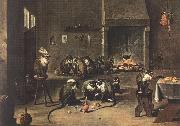 |
TENIERS, David the Younger
|
|
Flemish Baroque Era Painter, 1610-1690
a Flemish artist born in Antwerp, was the more celebrated son of David Teniers the Elder, almost ranking in celebrity with Rubens and Van Dyck. His son David Teniers III and his grandson David Teniers IV were also painters. His wife Anna nee, Anna Breughel was the daughter of Jan Brueghel the Elder and the granddaughter of Pieter Bruegel the Elder. Through his father, he was indirectly influenced by Elsheimer and by Rubens. The influence of Adriaen Brouwer can be traced to the outset of his career. There is no evidence, however, that either Rubens or Brouwer interfered in any way with Teniers's education, and Smith (Catalogue Raisonn) may be correct in supposing that the admiration which Brouwer's pictures at one time excited alone suggested to the younger artist his imitation of them. The only trace of personal relations having existed between Teniers and Rubens is the fact that the ward of the latter |
|
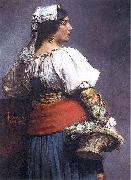 |
Teodor Axentowicz
|
|
born May 13, 1859 in Braşov, Romania - August 26, 1938 in Krakew) was a Polish-Armenian painter and university professor. A renowned artist of his times, he was also the rector of the Academy of Fine Arts in Krakew. As an artist, Axentowicz was famous for his portraits and subtle scenes of Hutsul life, set in the Carpathians.
Axentowicz was born May 13, 1859 in Braşov, Hungary (now Romania), to a family of Polish-Armenian ancestry. In 1893 in Chelsea, London, he married Iza Henrietta Gielgud, aunt of Val Gielgud and John [Arthur] Gielgud of the theatrical dynasty. A son, Philip S.A.D. Axentowicz was born in Chelsea in 1893.
Between 1879 and 1882 he studied at the Academy of Fine Arts in Munich. From there he moved to Paris, where he continued his education until 1895. During that time he started a long-time cooperation with various journals and started his career as a copyist, duplicating the works of Tizian and Botticelli. He also made numerous travels to London and Rome, where he prepared a set of portraits, one of the first in his career.
|
|
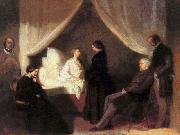 |
Teofil Kwiatkowski
|
|
(February 21, 1809, Pułtusk - August 14, 1891, Avallon, France) was a Polish painter.
Kwiatkowski participated in the November 1830 Uprising. After its suppression, he emigrated to France.
His artistic work includes many images of Frederic Chopin, including a picture of him playing at a ball at Paris's Hôtel Lambert and Chopin on His Deathbed (1849).
|
|
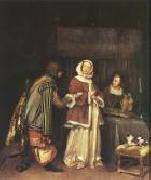 |
TERBORCH, Gerard
|
|
Dutch Baroque Era Painter, 1617-1681
Dutch genre and portrait painter. He studied with his father and traveled throughout Europe, showing extraordinary precocity in his early work. In 1648 he attended the congress at Menster and painted portraits of the delegates that he incorporated in his celebrated group, The Peace of Menster (National Gall., London). Soon after, he was invited to Spain, where he worked for Philip IV. On returning to Holland in 1650 he painted a variety of genre scenes, capturing the individuality of each subject and portraying the life and customs of the wealthy burgher class with rare dignity and distinction. The tiny portraits and the interiors that were his specialty are painted with elegance, serenity, and a technique of consummate craftsmanship. Among his most famous pictures are Self-Portrait and The Toilet (The Hague), and The Guitar Lesson (National Gall., London). |
|
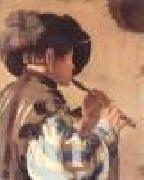 |
TERBRUGGHEN, Hendrick
|
|
Dutch Baroque Era Painter, ca.1588-1629
Dutch painter, a leading member of the Utrecht school. He was a pupil of the history painter Bloemaert before living (c.1604?C14) in Italy. Crowning of Thorns (1620; Copenhagen) is his first known dated work. Like his contemporaries Honthorst and Baburen, he was largely influenced by Caravaggio, although an awareness of D??rer and Lucas van Leyden recurs throughout his work. His intimate and restrained genre compositions foreshadow in coloring the work of Vermeer. Many of Terbrugghen's paintings are nighttime genre scenes. His work is represented in the major European museums. Typical examples are his St. Sebastian (Allen Mus., Oberlin, Ohio), Old Man Writing |
|
|
|
 |
Testelin,Henri
|
|
French , 1616-1695
Painter, printmaker and writer, brother of Louis Testelin. As a member of the circle of Charles Le Brun, he endorsed his connection with the Academie Royale by submitting an allegorical portrait of Louis XIV in Childhood as Patron of the Arts as his morceau de reception. He was secretary of the Acad?mie from 1650 and a professor from 1656. He produced several tapestry cartoons based on designs by Le Brun for the Gobelins, including the Wedding of Louis XIV and Maria-Theresa on 9 June 1660 (before 1665) and the Founding of the Academie des Sciences and the Observatory in 1666. He was active also as a court portrait painter, exhibiting portraits of Louis XIV as Patron of the Academie Royale de Peinture et de Sculpture (exh. Salon 1673; Versailles, Cheteau) and of Maria-Theresa, Queen of France . Also at the Salon of 1673 he showed a history painting, |
|
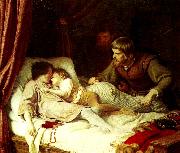 |
th. hildebrandt
|
|
Ferdinand Theodor Hildebrandt, född 2 juli 1804 i Stettin, död 29 september 1874 i Dusseldorf, var en tysk målare.
Hildebrandt började sina konstnärliga studier i Berlin under Wilhelm Schadow, vilken han 1826 följde till Dusseldorf, och blev en av den där grundade skolans mest framstående lärjungar. 1825 framträdde han med Faust, 1826 med Cordelia och kung Lear och 1828 med Tankred döpande Klorinda. Ännu större popularitet vann han 1835 för Mordet på kung Edvards söner. Bland hans genrebilder har i synnerhet Krigaren och hans son (1832, Berlins nationalgalleri) blivit känd. Hildebrandt, som för övrigt utförde illustrationer och porträtt, kallades på sin tid realist, men han var knappast fri från den melodramatiska ton och den sentimentala inställning, som tillhörde skolan. |
|
|

